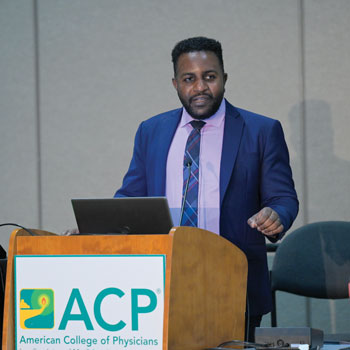Work toward equity in Black men's health
An expert discusses causes and effects of health disparities as well as ways to incorporate health equity into the practice of medicine.
Considering health equity requires more than just clinical knowledge, according to Robert O. Roswell, MD, FACP. At Internal Medicine Meeting 2023, he illustrated his point by asking the audience to identify which of the following is a health disparity affecting Black men.
“Is it that Black men suffer hypertension more than White men? Is it that Black men are hospitalized more frequently for transthyretin congestive heart failure than White men? Is it that Black men are more likely to die from suicide than White men? Or is it that Black men are prescribed hydralazine and nitrates for heart failure more than White men?”

The first answer is correct, said Dr. Roswell, who is the associate dean for diversity, equity, and inclusion and professor of science education and cardiology at the Northwell Health Zucker School of Medicine in Uniondale, N.Y. But to know that, he stressed, “you have to, one, know the clinical medicine, and then on top of that, you have to understand what are the driving factors for the disparity that you see.”
During his talk, “The Science of Adversity: Black Men's Health,” Dr. Roswell covered the causes and effects of health disparities as well as ways to incorporate health equity into the practice of medicine.
For Black men, three diseases contribute the most to disparities in mortality, Dr. Roswell said. According to a study published in November 2012 in the New England Journal of Medicine, 15% of excess mortality in Black men can be attributed to hypertension, 11.2% to HIV, and 8.5% to diabetes. “When you try to understand what are the drivers for some of these disparate outcomes, I think all too often we think about the biologic determinants, but you know that we're talking a lot about the social determinants of health,” he said.
A study published in the American Journal of Preventive Medicine in 2016 estimated that 40% of health outcomes are due to social and economic factors, such as education, employment, and community safety; 30% are due to health behaviors, such as diet and exercise and tobacco or alcohol use; 10% are due to the physical environment, such as air and water quality and housing and transit; and 20% are due to clinical care.
Dr. Roswell noted that some policy experts have begun advocating use of the term “political determinants of health,” since many of the disparities seen today are a result of political decisions made years ago. “When we think about it, and we say things are social determinants of health, it absolves the laws and the policies and the practices that made it that way,” he said.
These policies and practices, such as Jim Crow laws, segregation, and redlining, have a cascading effect, leading to racial bias in the justice system, concentrated poverty, and poor access to health care, education, and safe housing, among other factors, Dr. Roswell said. Such structural racism can then cause toxic stress, which is different from the kinds that affect all of us, he explained: “There's stress of presenting at ACP in front of your colleagues, and then there's stress where you don't know where your next meal is coming from, and you're constantly discriminated [against], and you're living under those conditions.”
Evidence of this problem comes from a study published in Circulation Research in 2022, which found that people living with chronic psychosocial and environmental stressors have chronic amygdala activation on positron emission tomography, leading to elevated white blood cells counts, increased dopamine and glucocorticoids, and higher epinephrine and norepinephrine levels.
“These are fight-and-flight sort of responses, but what happens when you're chronically stressed, when this has happened to you every day, you have elevated levels of these all the time,” Dr. Roswell said. This can in turn cause an increase in inflammation, he said.
In addition, people who are chronically stressed have telomere shortening and methylation of their DNA, which means that the cells will undergo apoptosis at higher rates and die sooner. “My colleagues [and I], when we receive a microaggression … we have to learn to let it go, and we usually say, ‘I'm not going to let my telomeres shorten today, I'm not going to let my telomeres shorten today.’ Because this is what happens when you're under chronic stress in an environment. Your telomeres actually start to shrink,” Dr. Roswell said.
Both structural racism and stigma play a large part in health disparities seen in HIV patients, Dr. Roswell noted. He discussed the case of a 26-year-old HIV-positive Black gay man who was prescribed antiretroviral therapy, had a history of chronic systolic cardiomyopathy, and had many hospitalizations for heart failure. The patient presented to the hospital with dyspnea, fatigue, cardiogenic shock, an ejection fraction of 10%, and a decreasing CD4 cell count with detectable viral load. After he was stabilized in the ICU, Dr. Roswell recommended workup for a left ventricular assist device (LVAD).
“When I tried to do that, [the heart failure team] said, ‘Are you kidding me? We can't do an LVAD in a patient like this,’” Dr. Roswell said. LVAD is an expensive, complicated device that requires extensive patient education and social support to use its alarm system, he explained. “There's a green alarm, there's a red alarm, there's a yellow alarm. You have to know each one of those alarms, because if you have a red alarm, meaning that the machine is about to malfunction, you have to get to your LVAD center, because then the blood will stop flowing, and you will die. You also have to be accompanied by people who also know those instructions.”
Dr. Roswell noted that many Black gay men have particular difficulty accessing care and support and may be especially isolated. “[As a Black man], you have society who doesn't know are you a threat or not, so you really, really lean on your community for support. As a Black gay man, you might not be welcomed in the church, so you have lost that as well. Then all you have is your family, and then put HIV on top of that, you have a huge, huge burden, and that goes into people really just giving up,” he said.
As a Black gay physician, Dr. Roswell said, he was able to connect with the patient. “I talked to him and said … ‘You can't give up. I know what you're going through. This is hard. But you can do this. Start taking your medication. They're saying that you don't deserve the LVAD; you're going to get an LVAD.’”
The patient agreed to start taking the necessary medications, his viral load began decreasing, and he was transferred to receive an LVAD after his hospitalization. He also became a patient advocate for others considering this treatment. “What if [another physician] were there who didn't understand the stigma of HIV disparities and Black men?” Dr. Roswell said. “Where would this young man be?”
This example, and others in the literature, show the importance of having diverse clinicians in medicine, Dr. Roswell said. He pointed to a study done in California and published in the American Economic Review in 2019, which found that Black male patients were more likely to agree to primary care interventions, particularly invasive interventions, after meeting with a Black versus a non-Black doctor. The authors estimated that Black doctors could reduce the Black-White gap in cardiovascular mortality in men by 19%, Dr. Roswell said. Having more Black primary care physicians in the workforce was also associated with improved survival for Black patients in a study published in JAMA Network Open in 2023, while a cross-sectional analysis published in the same journal in 2020 found an association between patient satisfaction and racial/ethnic concordance between patients and physicians.
“This is really important that we all need to advocate for having more diversity in medical schools, and then bringing [diverse physicians] into internal medicine and other subspecialties, because it's of a critical consequence,” Dr. Roswell said.
He also noted the importance of training staff about issues of health equity. “We have to really understand stigma and how it drives [outcomes], get our teams trained in inclusive training. … Everybody that's involved in touching that patient has a role,” he said. He gave the example of a patient with HIV who wanted to get a blood test because he was concerned he might have another sexually transmitted infection.
“The phlebotomist said, ‘I can't believe it. You have HIV and you're coming in for these tests? Like when are you going to get it together?’” Dr. Roswell said. In response, the patient said he would never seek medical care again because he couldn't face that type of judgment.
Dr. Roswell reminded his audience that every member of the staff, not just the physician, is part of the patient care team. “If they don't approach patients with that cultural humility and empathy, [the patients] don't even get to us,” he said. “Think about inclusive training for your whole team. … I think this is one way that we can advance health equity.”
The last section of Dr. Roswell's talk covered disparities in colorectal cancer. Incidence and mortality are both higher in Black men, due in part to disparities in screening and to delays in treatment, he said.
Black patients were 46% more likely than White patients to report that they hadn't been screened for colorectal cancer because it hadn't been recommended in a cross-sectional study published in the American Journal of Gastroenterology in 2015, while a study published in Cancer Epidemiology, Biomarkers & Prevention in 2021 found that Hispanic and Black patients were at increased risk for both undertreatment and treatment delay versus White patients.
“There's a great amount of evidence to say that we should have health screenings in the community and patient navigators to help us with these disparities,” Dr. Roswell said. Black men who received telephone-based patient navigation by a community health worker had a higher likelihood of completed colorectal cancer screening at six months, according to a study published in the American Journal of Public Health in 2017. Similarly, a hypertension intervention at Black barbershops helped to decrease blood pressure among older Black male patrons in a study published in the New England Journal of Medicine in 2018.
But community-based interventions, while helpful, can't be the only solution, Dr. Roswell said. He challenged his listeners to think about their own role in working toward health equity. ACP and other professional societies need to continue to advocate for upstream interventions to “sort of disentangle these social determinants of health and provide equitable care for folks,” he added. “Because if they don't, we at the downstream end are going to continue to solve these problems, and figure out new and innovative ways of solving the problems, instead of stopping the source of the problem.”



